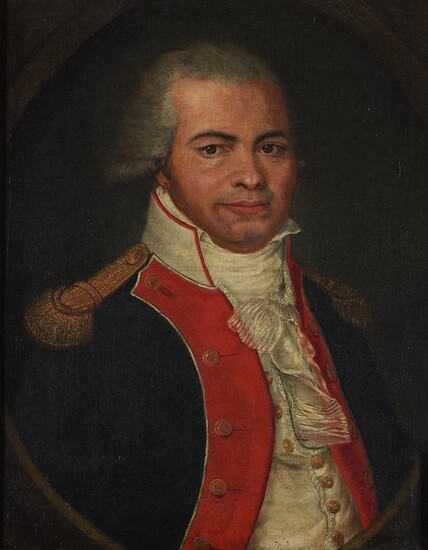FRENCH COLONIAL SCHOOL (CIRCA 1800), PORTRAIT OF AN OFFICER IN UNIFORM
FRENCH COLONIAL SCHOOL (CIRCA 1800)PORTRAIT OF AN OFFICER IN UNIFORMOil on canvas61 x 50cm (24 x 19½ in.)The portrait offered here has traditionally been identified as Hispanic, with the uniform style dating the work to around c.1790. The two fringed epaulettes would denote the rank of captain in a Spanish unit at home or overseas. However, for this to be the case the uniform is unusual. Since 1792, the "Disciplined Militia" in all overseas territories was to wear a blue coat with scarlet collar, cuffs and lapels, gold buttons for infantry and silver for cavalry. This is seen in many portraits without the white piping. In this case we also have a white collar with scarlet piping. More recently it has been suggested that the uniform is like that worn by some French revolutionary Gardes Nationale units in 1789-1790. An order of 19 July 1790 specified for the National Guard the blue coat with scarlet cuffs and lapels piped white and the white collar piped scarlet, gold buttons and on 3 October 1789, the National Guard of Charleville had adopted earlier that same uniform. However, the Paris National Guard had scarlet cuffs and collar piped white and white pied scarlet lapels and that is finally what was imposed on all National Guards on 29 September 1791 and, eventually, for the regular line infantry that wore those colours until 1816. For a similar example of this uniform see the portrait by Remi-Furcy Descarsin A National Guard and his Wife, 1791, in the collection of the Musee de la Revolution Française, MRF 2004-14. The small earring on the visible right ear lobe is not something often seen any military officer's portrait, although this is seen on southern European men at times during this period and it has been suggested that this may be a portrait of a French Colonial officer. According to a 15 March 1790 decree (see Sidney Daney de Marcillac, Histoire de la Martinique: Depuis la Colonisation Jusqu'en 1815, Vol 5, Fort Royal, 1846) the National Guard of Saint-Domingue (now Haiti) was to wear the same uniform as that of France. Each corps was to have the name of its district on its buttons. The other French islands (Martinique, Guadeloupe, etc) were also wearing the "national" [guard] uniform from 1790, changing from previous red lapel uniforms to white lapels around the mid-1790s, as in France. We are grateful to René Chartrand for his kind assistance with cataloguing this lot. Condition Report: The canvas has been relined. Some creasing to the canvas caused by the relining. Craquelure and surface dirt throughout. A horizontal stretcher mark running through the centre of the composition. Ultraviolet light reveals a green cloudy varnish and retouching throughout.Condition Report Disclaimer
[ translate ]View it on
Estimate
Time, Location
Auction House
FRENCH COLONIAL SCHOOL (CIRCA 1800)PORTRAIT OF AN OFFICER IN UNIFORMOil on canvas61 x 50cm (24 x 19½ in.)The portrait offered here has traditionally been identified as Hispanic, with the uniform style dating the work to around c.1790. The two fringed epaulettes would denote the rank of captain in a Spanish unit at home or overseas. However, for this to be the case the uniform is unusual. Since 1792, the "Disciplined Militia" in all overseas territories was to wear a blue coat with scarlet collar, cuffs and lapels, gold buttons for infantry and silver for cavalry. This is seen in many portraits without the white piping. In this case we also have a white collar with scarlet piping. More recently it has been suggested that the uniform is like that worn by some French revolutionary Gardes Nationale units in 1789-1790. An order of 19 July 1790 specified for the National Guard the blue coat with scarlet cuffs and lapels piped white and the white collar piped scarlet, gold buttons and on 3 October 1789, the National Guard of Charleville had adopted earlier that same uniform. However, the Paris National Guard had scarlet cuffs and collar piped white and white pied scarlet lapels and that is finally what was imposed on all National Guards on 29 September 1791 and, eventually, for the regular line infantry that wore those colours until 1816. For a similar example of this uniform see the portrait by Remi-Furcy Descarsin A National Guard and his Wife, 1791, in the collection of the Musee de la Revolution Française, MRF 2004-14. The small earring on the visible right ear lobe is not something often seen any military officer's portrait, although this is seen on southern European men at times during this period and it has been suggested that this may be a portrait of a French Colonial officer. According to a 15 March 1790 decree (see Sidney Daney de Marcillac, Histoire de la Martinique: Depuis la Colonisation Jusqu'en 1815, Vol 5, Fort Royal, 1846) the National Guard of Saint-Domingue (now Haiti) was to wear the same uniform as that of France. Each corps was to have the name of its district on its buttons. The other French islands (Martinique, Guadeloupe, etc) were also wearing the "national" [guard] uniform from 1790, changing from previous red lapel uniforms to white lapels around the mid-1790s, as in France. We are grateful to René Chartrand for his kind assistance with cataloguing this lot. Condition Report: The canvas has been relined. Some creasing to the canvas caused by the relining. Craquelure and surface dirt throughout. A horizontal stretcher mark running through the centre of the composition. Ultraviolet light reveals a green cloudy varnish and retouching throughout.Condition Report Disclaimer
[ translate ]


